Abstract
Addition of sodium butyrate to the culture medium of the human hepatoma cell line Hep G2 resulted in a time- and dose-dependent increase in the secretion of apolipoprotein A-I (apo A-I) and apolipoprotein B100 (apo B100). After a 24 h preincubation period, a 2.4- and 2.2-fold increase in the secretion of apo A-I and apo B100 respectively was obtained during the next 24 h in the presence of 2 mM-sodium butyrate. Secretion of albumin, fibrinogen or [35S]methionine-labelled newly synthesized proteins was unaffected or only marginally affected, indicating that the effect of butyrate on apo A-I and apo B100 is not part of a general effect on protein synthesis and secretion. In structure-function studies, butyrate was found to be the most potent inducer among various straight-chain carboxylic acids. Hydroxylated, aminated and otherwise modified butyrate derivatives were inactive. The enhanced accumulation of apo A-I and apo B100 in the culture medium could not be explained by changes in the uptake and degradation of the synthesized apolipoproteins or by alterations in the secretion of possible intracellular pools. In addition, [35S]methionine incorporation studies indicated that synthesis and/or secretion of newly synthesized apo A-I and apo B100 is enhanced in the presence of butyrate. The apo A-I mRNA level was increased 2.3-fold upon treatment with 2 mM-butyrate for 48 h, suggesting regulation at (post-)transcriptional level. In contrast, no change in the level of apo B100 mRNA in butyrate-treated cells was observed, indicating regulation at translational or co- or post-translational level. We propose that the effect of butyrate on the secretion of apo A-I and apo B100 by Hep G2 results from two different regulatory mechanisms.
Full text
PDF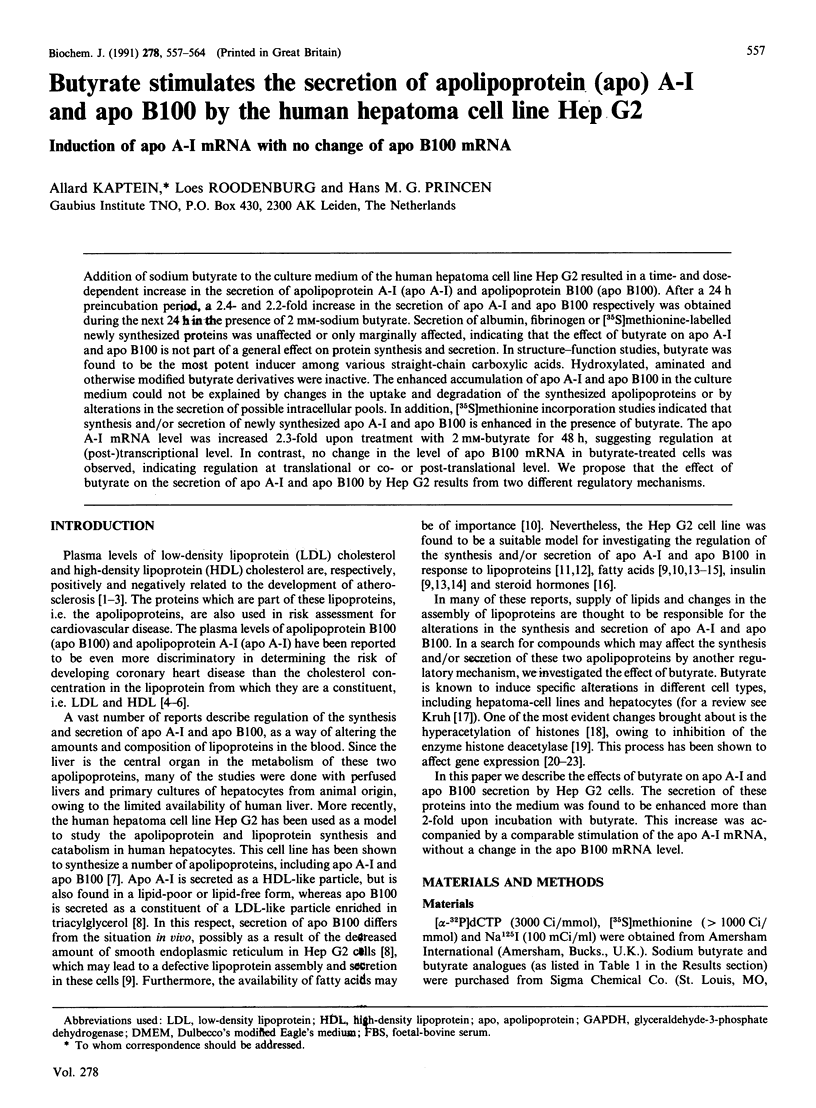

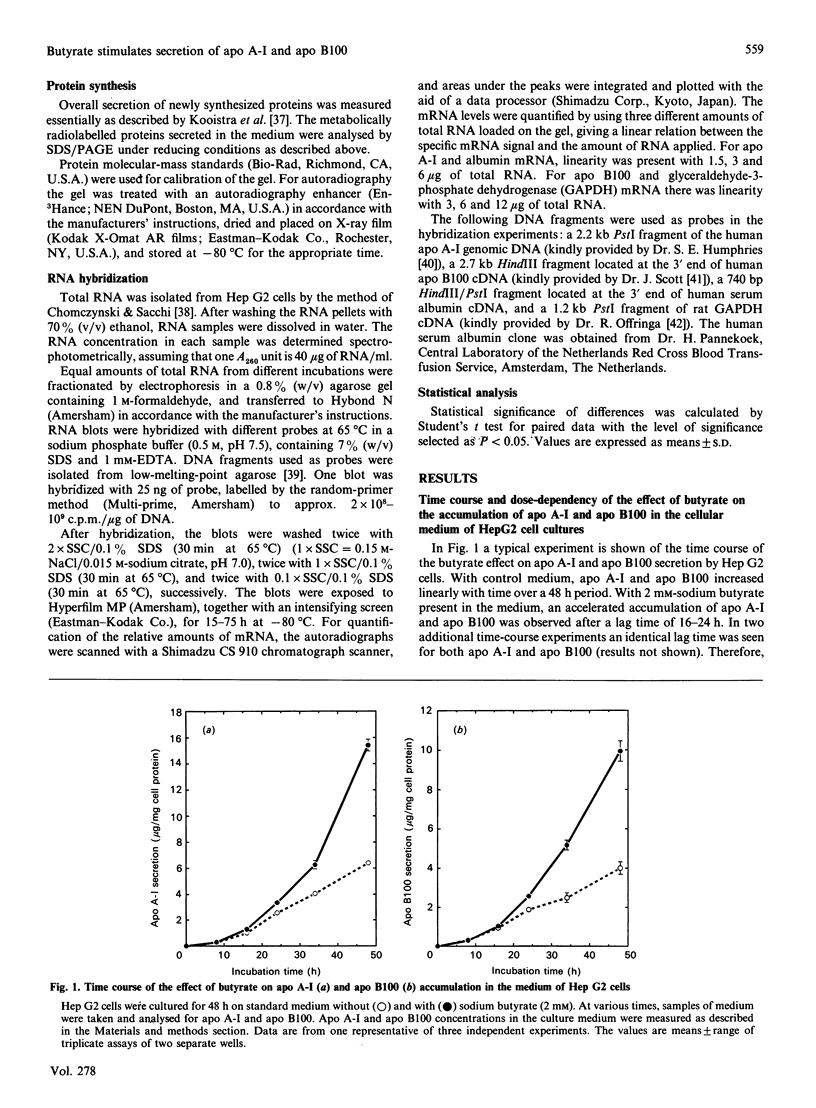

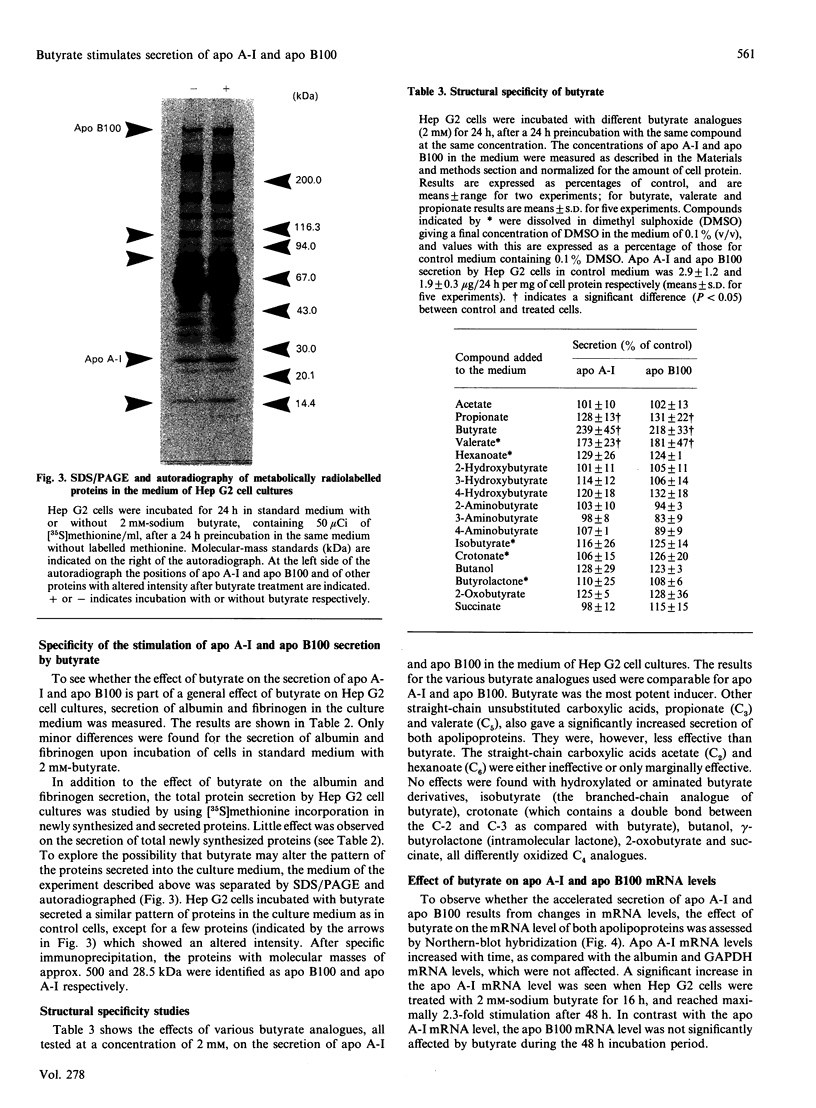
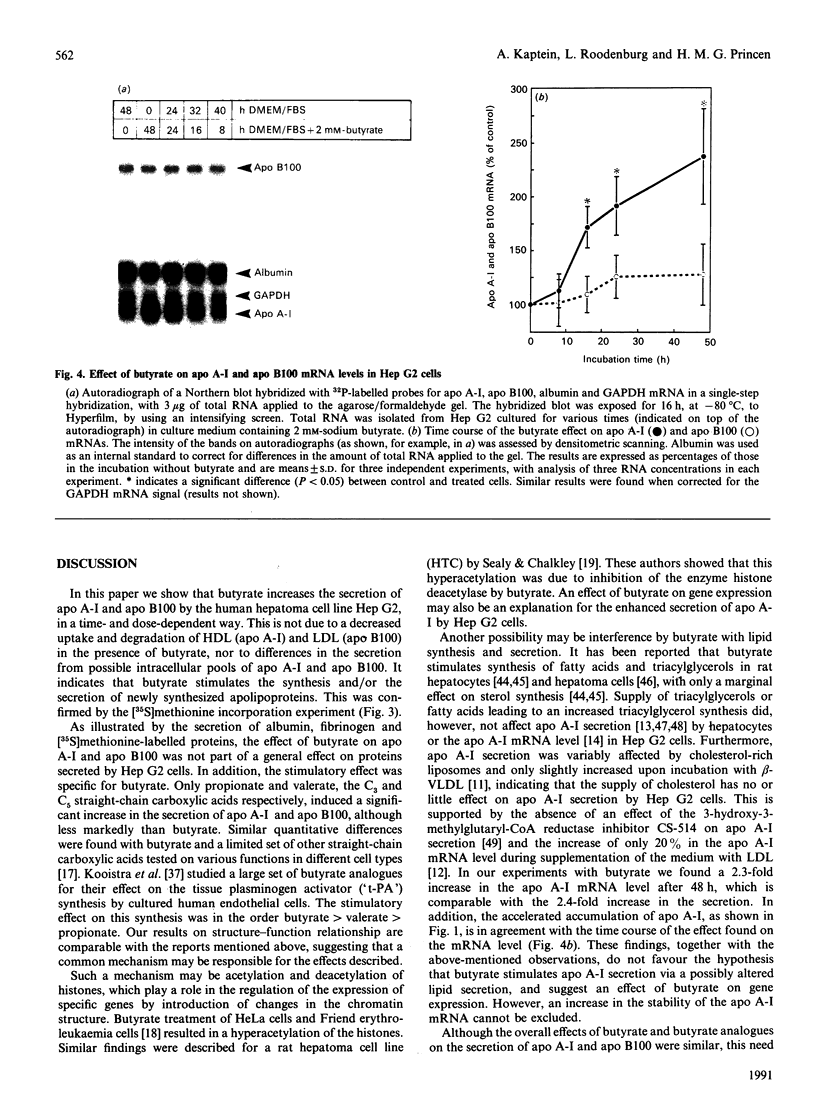
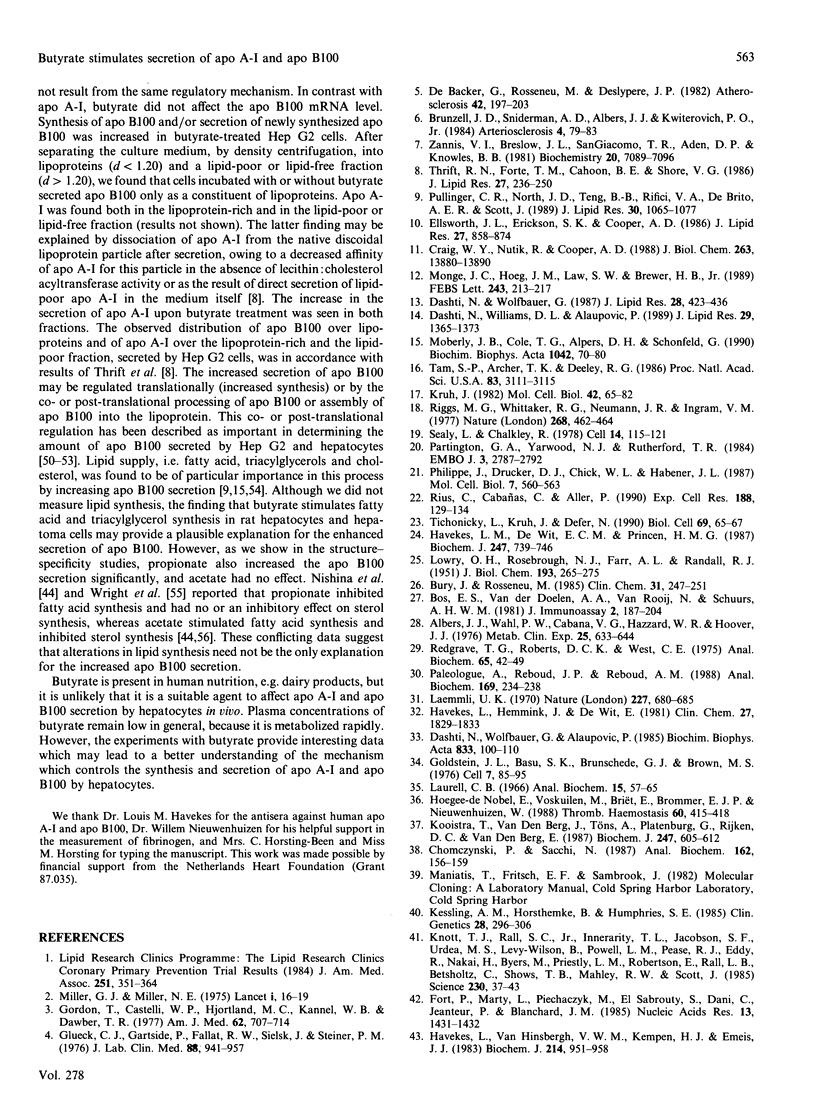

Images in this article
Selected References
These references are in PubMed. This may not be the complete list of references from this article.
- Albers J. J., Wahl P. W., Cabana V. G., Hazzard W. R., Hoover J. J. Quantitation of apolipoprotein A-I of human plasma high density lipoprotein. Metabolism. 1976 Jun;25(6):633–644. doi: 10.1016/0026-0495(76)90060-3. [DOI] [PubMed] [Google Scholar]
- Beynen A. C., Buechler K. F., Van der Molen A. J., Geelen M. J. The effects of lactate and acetate on fatty acid and cholesterol biosynthesis by isolated rat hepatocytes. Int J Biochem. 1982;14(3):165–169. doi: 10.1016/0020-711x(82)90135-5. [DOI] [PubMed] [Google Scholar]
- Borén J., Wettesten M., Sjöberg A., Thorlin T., Bondjers G., Wiklund O., Olofsson S. O. The assembly and secretion of apoB 100 containing lipoproteins in Hep G2 cells. Evidence for different sites for protein synthesis and lipoprotein assembly. J Biol Chem. 1990 Jun 25;265(18):10556–10564. [PubMed] [Google Scholar]
- Bos E. S., van der Doelen A. A., van Rooy N., Schuurs A. H. 3,3',5,5' - Tetramethylbenzidine as an Ames test negative chromogen for horse-radish peroxidase in enzyme-immunoassay. J Immunoassay. 1981;2(3-4):187–204. doi: 10.1080/15321818108056977. [DOI] [PubMed] [Google Scholar]
- Brunzell J. D., Sniderman A. D., Albers J. J., Kwiterovich P. O., Jr Apoproteins B and A-I and coronary artery disease in humans. Arteriosclerosis. 1984 Mar-Apr;4(2):79–83. doi: 10.1161/01.atv.4.2.79. [DOI] [PubMed] [Google Scholar]
- Bury J., Rosseneu M. Quantification of human serum apolipoprotein AI by enzyme immunoassay. Clin Chem. 1985 Feb;31(2):247–251. [PubMed] [Google Scholar]
- Carmona A., Freedland R. A. Comparison among the lipogenic potential of various substrates in rat hepatocytes: the differential effects of fructose-containing diets on hepatic lipogenesis. J Nutr. 1989 Sep;119(9):1304–1310. doi: 10.1093/jn/119.9.1304. [DOI] [PubMed] [Google Scholar]
- Chomczynski P., Sacchi N. Single-step method of RNA isolation by acid guanidinium thiocyanate-phenol-chloroform extraction. Anal Biochem. 1987 Apr;162(1):156–159. doi: 10.1006/abio.1987.9999. [DOI] [PubMed] [Google Scholar]
- Chuck S. L., Yao Z., Blackhart B. D., McCarthy B. J., Lingappa V. R. New variation on the translocation of proteins during early biogenesis of apolipoprotein B. Nature. 1990 Jul 26;346(6282):382–385. doi: 10.1038/346382a0. [DOI] [PubMed] [Google Scholar]
- Craig W. Y., Nutik R., Cooper A. D. Regulation of apoprotein synthesis and secretion in the human hepatoma Hep G2. The effect of exogenous lipoprotein. J Biol Chem. 1988 Sep 25;263(27):13880–13890. [PubMed] [Google Scholar]
- Dashti N., Williams D. L., Alaupovic P. Effects of oleate and insulin on the production rates and cellular mRNA concentrations of apolipoproteins in HepG2 cells. J Lipid Res. 1989 Sep;30(9):1365–1373. [PubMed] [Google Scholar]
- Dashti N., Wolfbauer G., Alaupovic P. Binding and degradation of human high-density lipoproteins by human hepatoma cell line HepG2. Biochim Biophys Acta. 1985 Jan 9;833(1):100–110. doi: 10.1016/0005-2760(85)90257-7. [DOI] [PubMed] [Google Scholar]
- Dashti N., Wolfbauer G. Secretion of lipids, apolipoproteins, and lipoproteins by human hepatoma cell line, HepG2: effects of oleic acid and insulin. J Lipid Res. 1987 Apr;28(4):423–436. [PubMed] [Google Scholar]
- Davis R. A., Boogaerts J. R. Intrahepatic assembly of very low density lipoproteins. Effect of fatty acids on triacylglycerol and apolipoprotein synthesis. J Biol Chem. 1982 Sep 25;257(18):10908–10913. [PubMed] [Google Scholar]
- Davis R. A., Thrift R. N., Wu C. C., Howell K. E. Apolipoprotein B is both integrated into and translocated across the endoplasmic reticulum membrane. Evidence for two functionally distinct pools. J Biol Chem. 1990 Jun 15;265(17):10005–10011. [PubMed] [Google Scholar]
- De Backer G., Rosseneu M., Deslypere J. P. Discriminative value of lipids and apoproteins in coronary heart disease. Atherosclerosis. 1982 Apr;42(2-3):197–203. doi: 10.1016/0021-9150(82)90150-2. [DOI] [PubMed] [Google Scholar]
- Ellsworth J. L., Erickson S. K., Cooper A. D. Very low and low density lipoprotein synthesis and secretion by the human hepatoma cell line Hep-G2: effects of free fatty acid. J Lipid Res. 1986 Aug;27(8):858–874. [PubMed] [Google Scholar]
- Fuki I. V., Preobrazhensky S. N., Misharin AYu, Bushmakina N. G., Menschikov G. B., Repin V. S., Karpov R. S. Effect of cell cholesterol content on apolipoprotein B secretion and LDL receptor activity in the human hepatoma cell line, HepG2. Biochim Biophys Acta. 1989 Feb 6;1001(2):235–238. doi: 10.1016/0005-2760(89)90153-7. [DOI] [PubMed] [Google Scholar]
- Gibbons G. F. Assembly and secretion of hepatic very-low-density lipoprotein. Biochem J. 1990 May 15;268(1):1–13. doi: 10.1042/bj2680001. [DOI] [PMC free article] [PubMed] [Google Scholar]
- Glueck C. J., Gartside P., Fallat R. W., Sielski J., Steiner P. M. Longevity syndromes: familial hypobeta and familial hyperalpha lipoproteinemia. J Lab Clin Med. 1976 Dec;88(6):941–957. [PubMed] [Google Scholar]
- Goldstein J. L., Basu S. K., Brunschede G. Y., Brown M. S. Release of low density lipoprotein from its cell surface receptor by sulfated glycosaminoglycans. Cell. 1976 Jan;7(1):85–95. doi: 10.1016/0092-8674(76)90258-0. [DOI] [PubMed] [Google Scholar]
- Gordon T., Castelli W. P., Hjortland M. C., Kannel W. B., Dawber T. R. High density lipoprotein as a protective factor against coronary heart disease. The Framingham Study. Am J Med. 1977 May;62(5):707–714. doi: 10.1016/0002-9343(77)90874-9. [DOI] [PubMed] [Google Scholar]
- Havekes L. M., de Wit E. C., Princen H. M. Cellular free cholesterol in Hep G2 cells is only partially available for down-regulation of low-density-lipoprotein receptor activity. Biochem J. 1987 Nov 1;247(3):739–746. doi: 10.1042/bj2470739. [DOI] [PMC free article] [PubMed] [Google Scholar]
- Havekes L., Hemmink J., de Wit E. Low-density-lipoprotein apoprotein B in plasma as measured by radial immunodiffusion and rocket immunoelectrophoresis. Clin Chem. 1981 Nov;27(11):1829–1833. [PubMed] [Google Scholar]
- Havekes L., van Hinsbergh V., Kempen H. J., Emeis J. The metabolism in vitro of human low-density lipoprotein by the human hepatoma cell line Hep G2. Biochem J. 1983 Sep 15;214(3):951–958. doi: 10.1042/bj2140951. [DOI] [PMC free article] [PubMed] [Google Scholar]
- Hoegee-de Nobel E., Voskuilen M., Briët E., Brommer E. J., Nieuwenhuizen W. A monoclonal antibody-based quantitative enzyme immunoassay for the determination of plasma fibrinogen concentrations. Thromb Haemost. 1988 Dec 22;60(3):415–418. [PubMed] [Google Scholar]
- Kessling A. M., Horsthemke B., Humphries S. E. A study of DNA polymorphisms around the human apolipoprotein AI gene in hyperlipidaemic and normal individuals. Clin Genet. 1985 Oct;28(4):296–306. doi: 10.1111/j.1399-0004.1985.tb00403.x. [DOI] [PubMed] [Google Scholar]
- Knott T. J., Rall S. C., Jr, Innerarity T. L., Jacobson S. F., Urdea M. S., Levy-Wilson B., Powell L. M., Pease R. J., Eddy R., Nakai H. Human apolipoprotein B: structure of carboxyl-terminal domains, sites of gene expression, and chromosomal localization. Science. 1985 Oct 4;230(4721):37–43. doi: 10.1126/science.2994225. [DOI] [PubMed] [Google Scholar]
- Kooistra T., van den Berg J., Töns A., Platenburg G., Rijken D. C., van den Berg E. Butyrate stimulates tissue-type plasminogen-activator synthesis in cultured human endothelial cells. Biochem J. 1987 Nov 1;247(3):605–612. doi: 10.1042/bj2470605. [DOI] [PMC free article] [PubMed] [Google Scholar]
- Kruh J. Effects of sodium butyrate, a new pharmacological agent, on cells in culture. Mol Cell Biochem. 1982 Feb 5;42(2):65–82. doi: 10.1007/BF00222695. [DOI] [PubMed] [Google Scholar]
- LOWRY O. H., ROSEBROUGH N. J., FARR A. L., RANDALL R. J. Protein measurement with the Folin phenol reagent. J Biol Chem. 1951 Nov;193(1):265–275. [PubMed] [Google Scholar]
- Laemmli U. K. Cleavage of structural proteins during the assembly of the head of bacteriophage T4. Nature. 1970 Aug 15;227(5259):680–685. doi: 10.1038/227680a0. [DOI] [PubMed] [Google Scholar]
- Miller G. J., Miller N. E. Plasma-high-density-lipoprotein concentration and development of ischaemic heart-disease. Lancet. 1975 Jan 4;1(7897):16–19. doi: 10.1016/s0140-6736(75)92376-4. [DOI] [PubMed] [Google Scholar]
- Moberly J. B., Cole T. G., Alpers D. H., Schonfeld G. Oleic acid stimulation of apolipoprotein B secretion from HepG2 and Caco-2 cells occurs post-transcriptionally. Biochim Biophys Acta. 1990 Jan 16;1042(1):70–80. doi: 10.1016/0005-2760(90)90058-6. [DOI] [PubMed] [Google Scholar]
- Monge J. C., Hoeg J. M., Law S. W., Brewer H. B., Jr Effect of low density lipoproteins, high density lipoproteins, and cholesterol on apolipoprotein A-I mRNA in Hep G2 cells. FEBS Lett. 1989 Jan 30;243(2):213–217. doi: 10.1016/0014-5793(89)80132-2. [DOI] [PubMed] [Google Scholar]
- Nishina P. M., Freedland R. A. Effects of propionate on lipid biosynthesis in isolated rat hepatocytes. J Nutr. 1990 Jul;120(7):668–673. doi: 10.1093/jn/120.7.668. [DOI] [PubMed] [Google Scholar]
- Paleologue A., Reboud J. P., Reboud A. M. Selective silver-staining methods for RNA and proteins in the same polyacrylamide gels. Anal Biochem. 1988 Mar;169(2):234–238. doi: 10.1016/0003-2697(88)90279-5. [DOI] [PubMed] [Google Scholar]
- Partington G. A., Yarwood N. J., Rutherford T. R. Human globin gene transcription in injected Xenopus oocytes: enhancement by sodium butyrate. EMBO J. 1984 Dec 1;3(12):2787–2792. doi: 10.1002/j.1460-2075.1984.tb02210.x. [DOI] [PMC free article] [PubMed] [Google Scholar]
- Patsch W., Tamai T., Schonfeld G. Effect of fatty acids on lipid and apoprotein secretion and association in hepatocyte cultures. J Clin Invest. 1983 Jul;72(1):371–378. doi: 10.1172/JCI110977. [DOI] [PMC free article] [PubMed] [Google Scholar]
- Philippe J., Drucker D. J., Chick W. L., Habener J. F. Transcriptional regulation of genes encoding insulin, glucagon, and angiotensinogen by sodium butyrate in a rat islet cell line. Mol Cell Biol. 1987 Jan;7(1):560–563. doi: 10.1128/mcb.7.1.560. [DOI] [PMC free article] [PubMed] [Google Scholar]
- Pullinger C. R., North J. D., Teng B. B., Rifici V. A., Ronhild de Brito A. E., Scott J. The apolipoprotein B gene is constitutively expressed in HepG2 cells: regulation of secretion by oleic acid, albumin, and insulin, and measurement of the mRNA half-life. J Lipid Res. 1989 Jul;30(7):1065–1077. [PubMed] [Google Scholar]
- Redgrave T. G., Roberts D. C., West C. E. Separation of plasma lipoproteins by density-gradient ultracentrifugation. Anal Biochem. 1975 May 12;65(1-2):42–49. doi: 10.1016/0003-2697(75)90488-1. [DOI] [PubMed] [Google Scholar]
- Riggs M. G., Whittaker R. G., Neumann J. R., Ingram V. M. n-Butyrate causes histone modification in HeLa and Friend erythroleukaemia cells. Nature. 1977 Aug 4;268(5619):462–464. doi: 10.1038/268462a0. [DOI] [PubMed] [Google Scholar]
- Rius C., Cabañas C., Aller P. The induction of vimentin gene expression by sodium butyrate in human promonocytic leukemia U937 cells. Exp Cell Res. 1990 May;188(1):129–134. doi: 10.1016/0014-4827(90)90287-k. [DOI] [PubMed] [Google Scholar]
- Sato R., Imanaka T., Takano T. The effect of HMG-CoA reductase inhibitor (CS-514) on the synthesis and secretion of apolipoproteins B and A-1 in the human hepatoblastoma Hep G2. Biochim Biophys Acta. 1990 Jan 16;1042(1):36–41. doi: 10.1016/0005-2760(90)90053-z. [DOI] [PubMed] [Google Scholar]
- Sealy L., Chalkley R. The effect of sodium butyrate on histone modification. Cell. 1978 May;14(1):115–121. doi: 10.1016/0092-8674(78)90306-9. [DOI] [PubMed] [Google Scholar]
- Tam S. P., Archer T. K., Deeley R. G. Biphasic effects of estrogen on apolipoprotein synthesis in human hepatoma cells: mechanism of antagonism by testosterone. Proc Natl Acad Sci U S A. 1986 May;83(10):3111–3115. doi: 10.1073/pnas.83.10.3111. [DOI] [PMC free article] [PubMed] [Google Scholar]
- Thrift R. N., Forte T. M., Cahoon B. E., Shore V. G. Characterization of lipoproteins produced by the human liver cell line, Hep G2, under defined conditions. J Lipid Res. 1986 Mar;27(3):236–250. [PubMed] [Google Scholar]
- Tichonicky L., Kruh J., Defer N. Sodium butyrate inhibits c-myc and stimulates c-fos expression in all the steps of the cell-cycle in hepatoma tissue cultured cells. Biol Cell. 1990;69(1):65–67. doi: 10.1016/0248-4900(90)90329-2. [DOI] [PubMed] [Google Scholar]
- Wright P. S., Dudley D. T., Chalkley R. Butyrate effects on normal and adapted hepatoma cells: morphological response and implications for vectoral cholesterol transport. Arch Biochem Biophys. 1986 Jul;248(1):243–252. doi: 10.1016/0003-9861(86)90422-4. [DOI] [PubMed] [Google Scholar]
- Wright R. S., Anderson J. W., Bridges S. R. Propionate inhibits hepatocyte lipid synthesis. Proc Soc Exp Biol Med. 1990 Oct;195(1):26–29. doi: 10.3181/00379727-195-43113. [DOI] [PubMed] [Google Scholar]
- Zannis V. I., Breslow J. L., SanGiacomo T. R., Aden D. P., Knowles B. B. Characterization of the major apolipoproteins secreted by two human hepatoma cell lines. Biochemistry. 1981 Dec 8;20(25):7089–7096. doi: 10.1021/bi00528a006. [DOI] [PubMed] [Google Scholar]




